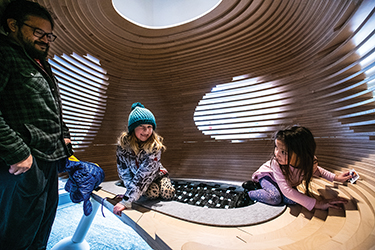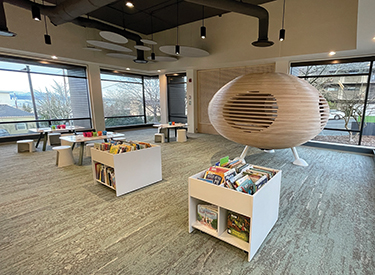|
Subscribe / Renew |
|
|
Contact Us |
|
| ► Subscribe to our Free Weekly Newsletter | |
| home | Welcome, sign in or click here to subscribe. | login |
Architecture & Engineering
| |
 |
February 29, 2024
Designing library spaces for the children of today
Johnston Architects

Chaffin
|
Since Andrew Carnegie reimagined public libraries and helped develop nearly 1,700 of them in the late 19th and early 20th centuries, how people use and interact in the spaces has changed immensely. Here in Seattle, we can visit the Columbia City Carnegie Library, which opened in 1915, and compare it to the current Capitol Hill branch, which opened in 2003, to see the remarkable transformation of community libraries that occurred in less than a century — and is still well underway.
Just as our society’s adoption of technology has quickened in the digital age, so has the evolution of the public library and what it provides: human engagement, access to technology, a welcoming gathering place, and much more.
In Johnston Architects’ 33-year history, we have designed nearly 40 library projects, and what has evolved most in recent decades is the design of children’s spaces.
IMAGINATIVE PLAY INSPIRES LEARNING
Sno-Isle Libraries and the city of Edmonds recognized an opportunity to broaden the Edmonds Library’s role in its community after the 17,000-square-foot facility was flooded by 60,000 gallons of water due to a burst water main.
Mona Johnston Zellers, a partner at JA, was an early childhood educator before she became an architect and brings that expertise to each of our library designs. Combining her understanding of early literacy with our firm’s parametric modeling capabilities and installation experience, we created several unique installations for the children’s area of the renovated Edmonds Library.
The most tactile of these resembles a pebble, egg, bird’s nest or a flying saucer, depending on who you ask. Designed to spark imaginative play, the installation uses one-inch thick Baltic Birch plywood in layers to create the form. JA developed the design and provided the digital fabrication files for construction. The files were optimized to limit the material waste, and 48 four feet by eight feet plywood sheets were used in its creation. Haskett Works fabricated, assembled, and installed the project in the library. The final product is about nine feet around and about seven feet tall. It sits on a partially hidden steel structure to ensure the safety of its little inhabitants.
When the Sno-Isle Libraries reopened the Edmonds Library on Jan. 13, this active play element was continually occupied by children of all ages, from crawling babies to tweens, and a few adults as well. When the library is less crowded, it can serve as a reading nook for caregivers and children, or a safe space for little ones to let out some energy before they sit down for story time. A focal point of the space, this reading retreat is also visible from outside, and will draw curious young readers into the library for many years to come.
DIGITAL AND ANALOG MERGE
We considered ways to spark a love of learning in young readers while also teaching them simplified concepts of circuitry, cause and effect, and programming through collaborative play.
We designed and constructed a floor-to-ceiling installation with 3,220 holes lit by individual LED lights, similar to a giant Lite-Brite toy. JA design technologist and associate Shane Leaman designed custom circuit boards to connect the 1,088 magnetic sensors behind the board, which sense when acrylic pegs embedded with a small magnet are inserted into the lower holes. When these pegs are inserted into the wall, the program responds using those LED lights in a myriad of ways.
Using a popular and simple gaming engine, Leaman created a number of games that engage this unique kind of input. Examples include programs in which players place pegs to pop bubbles descending on the screen, create a fireworks show, or create a pixel garden. The LED installation can be updated with new games at any time.
While the installation itself is digital, the interactions are more analog and the “screen” of individual lights appears like a pixel animation. When no one is interacting with the peg wall, it is programmed to rotate through a mix of colorful and dynamic displays, beckoning library patrons to the children’s area to see what all the fun is about.
As public libraries continue to evolve to meet the changing needs of their communities, library design must also evolve to incorporate technology in equitable ways and expand learning opportunities for children, strengthening early literacy through unique elements in the built environment. Ensuring these experiences are available to kids with differing mobilities, interests, cognitive needs and learning styles is vital to providing inclusive library experiences for all patrons. Inspiring a love of reading and learning among the library’s youngest patrons ensures the continued success and relevance of libraries in the future.
While Andrew Carnegie likely never imagined children crawling inside a reading “nest” in a public library, or playing spelling games on an oversized computer screen, we like to believe he would have maintained an open mind to new research in early literacy and recognized the value of engaging future readers in play to enhance learning. And who knows, perhaps he would have enjoyed playing in the library, too.
Jack Chaffin is a partner at Johnston Architects in Seattle, where he leads JA’s innovation lab.
Other Stories:
- The need for high-performance building enclosure design
- Bypassing review to boost affordability
- Seattle’s commercial development at a crossroads
- Designing for health in affordable housing
- Disrupting inequality in housing
- Trends transforming life-science building design
- Eight trends shaping design for cities in 2024
- Centering the patient and community in rural healthcare design
- Engineering with support from the sky
- Transforming yesterday’s spec office into the destination workplace of tomorrow
- An uncertain forecast for middle housing




